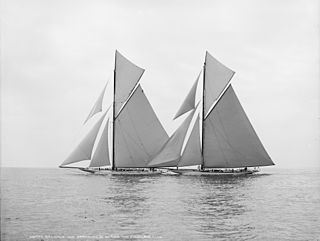
Brigadier General Cornelius "Neily" Vanderbilt III was an American military officer, inventor, engineer, and yachtsman. He was a member of the Vanderbilt family.

William Fife Jr., also known as William Fife III, was the third generation of a family of Scottish yacht designers and builders. In his time, William Fife designed around 600 yachts, including two contenders for the America's Cup. The Royal Yachting Association was formed in 1875 to standardise rules, and Fife and his rival G.L. Watson, were instrumental in these rule changes. Around one third of Fife's yachts still exist. His last designs were built in 1938.

Nathanael Greene Herreshoff was an American naval architect, mechanical engineer, and yacht design innovator. He produced a succession of undefeated America's Cup defenders between 1893 and 1920.

The J Class of racing yachts were built to the specifications of Nathanael Herreshoff's Universal Rule. The J Class is considered the apex of the era when the Universal Rule determined eligibility in the America's Cup.

Reliance was the 1903 America's Cup defender designed by Nat Herreshoff.

Defender was the victorious United States defender of the tenth America's Cup in 1895 against challenger Valkyrie III. Defender was designed by Nathanael Greene Herreshoff and built by the Herreshoff Manufacturing Company in 1895. It was Herreshoff's second victorious America's Cup defender design.

Valkyrie III, officially named Valkyrie, was the unsuccessful British challenger of the ninth America's Cup race in 1895 against American defender Defender.

Columbia was an American racing yacht built in 1899 for the America's Cup races. She was the defender of the tenth America's Cup race that same year against British challenger Shamrock as well as the defender of the eleventh America's Cup race in 1901 against British challenger Shamrock II. She was the first vessel to win the trophy twice in a row

His Majesty's Yacht Britannia was a gaff-rigged cutter built in 1893 for RYS Commodore Albert Edward, Prince of Wales. She served both himself and his son King George V with a long racing career.

George Lennox Watson was a Scottish naval architect. Born in Glasgow, son of Thomas Lennox Watson, a doctor at the Glasgow Royal Infirmary, and grandson of Sir Timothy Burstall, engineer and entrant at the 1829 Rainhill Trials.

Charles Ernest Nicholson was a British yacht designer.

Resolute was a yacht designed and built by Nathanael Greene Herreshoff for a syndicate of New York Yacht Club members headed by Henry Walters to contend the 1914 America's Cup.

The 1920 America's Cup was the 13th challenge for the Cup and the first since 1903. It took place in New York Harbor and consisted of a best-of-five series of races between the defender Resolute, entered by a syndicate of New York Yacht Club members headed by Henry Walters, and Shamrock IV, the fourth in Sir Thomas Lipton's line of Cup challengers. Charles Francis Adams III was the skipper of Resolute in this race.

Shamrock IV was a yacht owned by Sir Thomas Lipton and designed by Charles Ernest Nicholson. She was the unsuccessful challenger in the 1920 America's Cup. While the boat was launched in 1914, and soon towed across the Atlantic by Lipton's boat Erin, she was soon dry docked due to World War I. Shamrock IV was known as the 'ugly duckling' due to its scow-like bow.

Shamrock V is a British J-class yacht. She was the first British yacht to be built to the new J-Class rule. She was commissioned by Sir Thomas Lipton for his fifth America's Cup challenge. Although refitted several times, Shamrock is the only original J-class never to have fallen into dereliction.

The 1903 America's Cup was the 12th challenge for the Cup. It took place in the New York City harbor and consisted of a best of five series of races between Reliance, the fourth of Nathaniel Herreshoff's defenders for the cup, entered by the New York Yacht Club; and Shamrock III, representing the Royal Ulster Yacht Club and also the third of Sir Thomas Lipton's Cup challengers. Reliance won the first three races, defending the cup. It was the last race for the America's Cup that would take place under the Seawanhaka rule.

The 1901 America's Cup was the 11th challenge for the Cup. It took place in the New York City harbor and consisted of a best of five series of races between the defender Columbia, entered by the New York Yacht Club for the second time, and Sir Thomas Lipton's Shamrock II, representing the Royal Ulster Yacht Club. Columbia won all three races, the last being won with handicap, defending the cup.

The 1899 America's Cup was the 10th challenge for the Cup. It took place in the New York City harbor and consisted of a best of five series of races between the defender, Columbia, entered by the New York Yacht Club, and Sir Thomas Lipton's Shamrock, representing the Royal Ulster Yacht Club. Columbia won all three races against Shamrock.
The 1930 America's Cup was the 14th challenge for the Cup. It took place in Newport and consisted of a series of races between the defender Enterprise, entered by a syndicate of New York Yacht Club members headed by Winthrop Aldrich, and Shamrock V, the fifth in Sir Thomas Lipton's line of Cup challengers.
The America's Cup is the oldest international competition still operating in any sport.
















